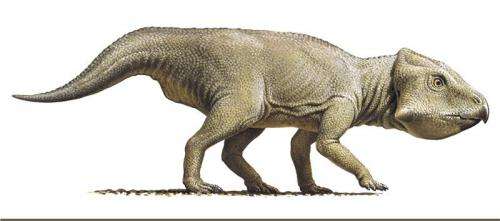Of dinosaurs and mathematics

Dinosaurs and mathematics do not seem like an obvious pair, but for Professor Robert Sinclair and his Mathematical Biology Unit, they are a logical match. Sinclair was part of a team that recently published a paper in Alcheringa: An Australasian Journal of Palaeontology that reexamined the classification of a dinosaur bone found in Australia. Using his expertise in mathematics, Sinclair was able to help the paleontologists reclassify a single arm bone as belonging to a dinosaur family previously believed not to have existed in the Southern Hemisphere. Sinclair contributed to an international, interdisciplinary collaboration that may lead to revisions in the current thinking about how continents were connected in the ancient world.
The bone in question, an ulna, or arm bone, was found in southern Australia. The researchers named this new species of dinosaur Serendipaceratops arthurcclarkei, and classified it as belonging to the Neoceratopsia family, which includes the famous dinosaur Triceratops. Not long after that paper was published, another research group published a paper saying that the bone could not be ceratopsian, partly because that family of dinosaurs existed only in the Northern Hemisphere and the land masses had already split, therefore there was no way that a bone from that family could be found in Australia. One caveat to this logic is that the data used to determine when the continents split is based on fossil data. "It becomes a chicken and egg scenario," says Sinclair. If the data used to establish a theory is then refuted by finding something unexpected, that theory should be challenged, which is not an easy thing to do.
This is where Sinclair can use mathematics to provide solid evidence for one theory or another. He is interested in using mathematics to solve difficult problems in fields of research where current methodologies are not sufficient. He was attracted to paleontology for this reason, particularly in his native Australia. After an invitation to speak at OIST, Dr. Thomas Rich, one of the Australian paleontologists on the paper, asked Sinclair for help in showing that the bone he had analyzed belonged to Ceratopsia.
Sinclair went about investigating whether the dimensions and characteristics of the bone matched other members of the Ceratopsia family, or whether they matched a different family. Sinclair said the challenge was to "use mathematics in a field where it is not commonly used or well understood and utilize it in a way that is understandable to those in the field." First he had to find a characteristic that could be measured on the bone in question and the same type of bone in other species and families of dinosaurs, in this case, the flatness of the bone. He had to mathematically account for variability in the bones since fossils tend to become broken or deformed over time. Some paleontologists were still skeptical of what the mathematics really meant. This is where the hard work began, and Sinclair had to find other measurements to make and used several different mathematical techniques to show that they all reached the same conclusion.
In the end, he showed mathematical data of three different types in order to convince certain paleontologists that the bone in question belonged to the Ceratopsia family. The driving point for Sinclair is using mathematics to tackle difficult questions when conventional methods in the field are not sufficient. His statistical analysis, combined with other analyses provided by the co-authors, was convincing enough to put the bone back into the Ceratopsia family.
Sinclair says he is excited about people finding more dinosaur bones in Australia to see how it challenges the current thinking about what did and did not exist on the continent. As for his other endeavors, he looks forward to working in new fields and figuring out the "dance of what you would do as a mathematician and what is accepted in that community." With that goal in mind, it is easy to see how dinosaurs and mathematics formed a logical pair for Sinclair.
More information: Rich, T.H., Kear, B.P., Sinclair, R., Chinnery, B., Carpenter, K., McHugh, M.L. & Vickers-Rich, P., 2014. "Serendipaceratops arthurcclarkei Rich & Vickers-Rich, 2003 is an Australian Early Cretaceous ceratopsian." Alcheringa 38. ISSN 0311-5518 . www.tandfonline.com/doi/full/1 … .894809#.U3MMH62SwmY
Provided by Okinawa Institute of Science and Technology



















